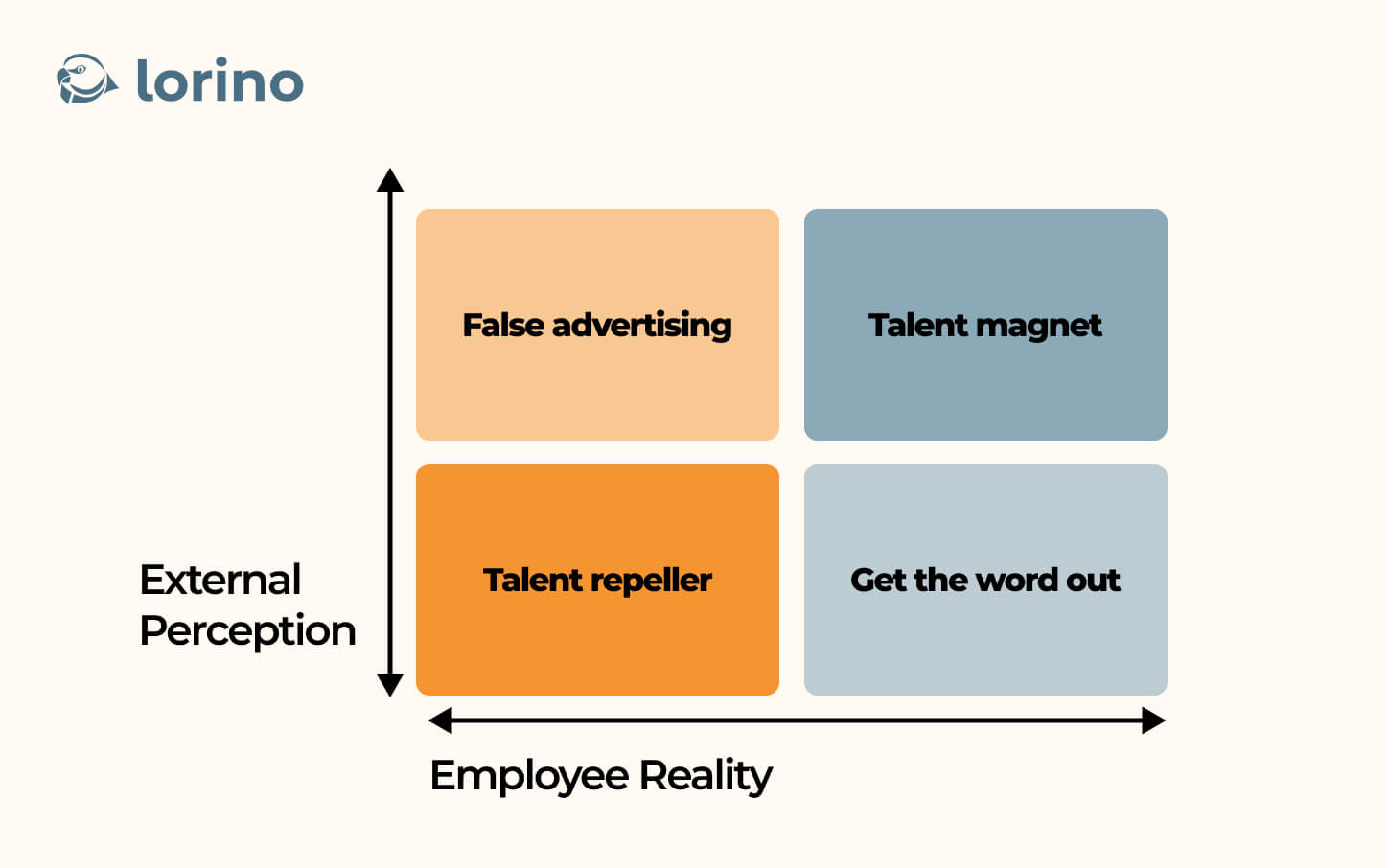Your employer brand represents how your company is perceived as an employer. Are you considered a great place to work, or want to be avoided at all costs?
When you hear Google, for example, you probably already have an idea about what it might be like to work there, and I can probably mention some other companies to which you attach some negative perceptions of them as an employer.

Whether you spend time and resources trying to build your employer brand or not, every company has one, because word gets out whether it’s curated or not.
In this article, we’ll be talking about the importance of an employer brand, the benefits a positive one brings, as well as steps to take to present your brand in the right light.
The Importance of Employer Brand
The importance of an employer brand cannot be overstated. It profoundly influences how your company is perceived as an employer, ultimately impacting your ability to attract and retain top talent.
A positive employer brand can be a powerful asset, making your organization an appealing destination for job seekers, while a negative one can deter potential candidates and even lead to high employee turnover.
A strong employer brand therefore has a lot of benefits, some of which are:
-
Expanding Your Talent Pool: A strong employer brand attracts a higher quantity and quality of job applicants. Top talent actively seeks out companies with positive reputations, increasing the likelihood of finding the right fit for your organization.
-
Reducing Hiring Costs: When you have a solid employer brand, you'll spend less on recruitment and advertising, as candidates are more likely to apply organically. Moreover, the cost of hiring and training decreases when employees are more likely to stay with your company.
-
Enhancing Your Reputation: A strong employer brand not only attracts potential employees but also enhances your reputation among customers, partners, and the public. A positive image can lead to increased business opportunities and partnerships.
-
Improving Performance: Engaged and satisfied employees are more productive, creative, and innovative. A strong employer brand fosters a culture of excellence and commitment, which, in turn, leads to improved performance.
How Do I Know What My Employer Brand Is?
Your employer brand can be looked at through a number of lenses. First of all, is the internal view. What do your current employees say about you as an employer?
Most companies already have data on this from their employee engagement survey. An annual survey of employee opinion will shed light on your strengths as an employer.
And secondly, it's really important to look at the external view. How you are perceived as an employer by potential employees, those candidates within the talent pool you want to recruit from.

The ideal position in this diagram is to be in the top right. Externally, you are perceived as an employer of choice, and internally your current employees agree. Companies in this quadrant are talent magnets and reap the benefits when it comes to recruitment.
At the opposite end of the scale, you have the talent repellers. Both internally and externally, you're not seen as a desirable employer. Companies in this quadrant have a lot of work to do and are no doubt struggling not only in terms of talent attraction, but they are probably also seeing an impact on their productivity, customer experience, and financial performance.
The off-diagonal quadrants are really interesting and we're seeing a lot of companies fall into one or other of these boxes. So the top left, the external view is very positive but that doesn't match the internal reality which is actually quite negative.
It may be easy enough to recruit talent but the promises you set them at recruitment are unfortunately not being lived in reality. We know recruitment is a very costly exercise and many companies in this false advertising quadrant lose employees within the first few months.
Finally, in the bottom right we have companies we say need to get the message out. Externally, candidates do not think of you as a good choice for a new employer but when you speak to them internally, your current workforce is highly engaged.
Many companies are sitting here and are struggling to understand what they need to do to appeal to the external talent pool.
How to Build a Strong Employer Brand
How you go about building a strong employer brand will depend on where you fall on the earlier-mentioned graph.
For companies that already have an engaged workforce, the true job will be broadcasting that more to the outside world. But if your surveys show that your internal affairs aren't settled, you should start with your culture.
But let’s go through the basics first:
1. Evaluate Your Company's Culture
Start by understanding your current culture and work environment. Collect feedback from current employees through surveys, interviews, and open forums to identify the strengths and weaknesses of your organization as an employer.
If your company culture isn’t engaging, there is no point in trying to advocate that it is, so fixing this will need to be your top priority - we have a list of tips for that further below.
2. Define Your Employer Value Proposition
Your Employer Value Proposition (EVP) is a cornerstone of your employer brand, outlining what your organization provides to employees in terms of benefits, workplace culture, and the overall employment experience.
To create a compelling EVP, begin by crafting a clear and concise message. Highlight your company's unique culture, core values, the advantages it provides, and the opportunities for personal and professional growth.
Moreover, it's crucial to ensure that you consistently deliver on the promises made in your EVP. Failing to do so can tarnish your brand's reputation and erode trust among your current and potential employees.
Lastly, make your EVP highly visible. Feature it prominently on your company website, weave it into job descriptions, and communicate it during interviews. This ensures that candidates who align with your values are naturally drawn to your organization.
3. Communicate Your Employer Brand
Whilst we’re on the topic of visibility, consider implementing a sustainable content strategy that highlights your organization's value.
Develop a long-term content strategy that showcases your culture, values, mission, and achievements across multiple channels. This includes your website, social media, job boards, and events.
Share employee testimonials, success stories, and behind-the-scenes content to provide potential candidates with an authentic look at your organization. Consistency in your messaging and branding is key to building a strong employer brand.
4. Create an Employee Advocacy Program
Recognize the invaluable potential of your employees as brand ambassadors. You can harness their support by offering incentives for promoting your company, sharing content, and referring professionals.
This strategy not only helps in building a stronger employer brand but also serves as a means of appreciating and acknowledging your employees. Incentives may take various forms, such as bonuses, gift cards, catered meals, or heartfelt thank-you notes and emails.
Most of your content and satisfied employees, who genuinely enjoy their work, will likely be more than willing to share their positive experiences, provided you initiate the conversation with them.
5. Measure and Improve Your Employer Brand
To ensure your employer branding efforts are effective, track relevant metrics like application rates, retention rates, employee satisfaction, and your employer's reputation.
Use this data to optimize your strategy continuously. Make adjustments based on feedback and performance indicators to maintain a positive employer brand.
How to Strengthen Your Brand from Within?
If you determine that your culture is actually the one lacking and that your workforce is not as engaged as you'd like them to be, your first step should be strengthening your brand from within.
As we mentioned before, there’s no point in advocating for your brand in order to attract talent, if they are going to leave out of disappointment in a few weeks.
Investing time and resources into strengthening your organizational culture and employee engagement should be therefore your top priority.
Here are some tips on how to do that:
1. Offer Opportunities for Professional Development
Employees often seek companies that support their career growth and development. To create a strong employer brand, consider these approaches:
-
Training Programs: Develop and offer training programs that align with employees' career aspirations. These programs could include workshops, webinars, or online courses.
-
Certification Support: Encourage employees to earn professional certifications relevant to their roles. You can cover certification costs or provide study materials.
-
Conference Attendance: Allow employees to attend industry conferences, seminars, and networking events. This not only enhances their skills but also demonstrates your commitment to their professional growth.
-
Mentorship Programs: Establish mentorship programs where experienced employees guide and support those who are new to the company. This fosters a culture of learning and development.
-
Individual Development Plans: Work with employees to create personalized development plans that map out their career progression within the company. Ensure that these plans are regularly reviewed and updated.
2. Create a Personalized Employee Experience
A personalized employee experience goes a long way in building a strong employer brand.
Here's how to achieve this:
-
Recognition Programs: Implement recognition and reward programs that acknowledge employees for exceptional work. This can include monthly awards, bonuses, or public acknowledgment of achievements.
-
Flexible Work Arrangements: Offer flexible work schedules or remote work options to accommodate individual needs. A work-life balance is highly valued by employees.
-
Wellness Initiatives: Promote employee well-being through wellness initiatives such as gym memberships, health screenings, or mental health support. Encourage a healthy work-life balance.
-
Individualized Career Pathing: Work with employees to define their career paths within the organization. Provide them with clear steps and timelines for achieving their career goals.
-
Employee Feedback: Continuously gather feedback from employees about their experiences and needs. Act on this feedback to improve their work environment.
3. Streamline Internal Communication
Effective internal communication can significantly impact your culture and your employer's brand. Clear and open communication can be established in the following ways:
-
Regular Updates: Provide regular updates on the company's goals, achievements, and future plans. Transparency builds trust and helps employees understand their roles in achieving company objectives.
-
Feedback Mechanisms: Establish channels for employees to share their thoughts and concerns. Conduct regular surveys or feedback sessions to gather insights and address issues promptly.
-
Company Mission Alignment: Ensure that employees understand and are aligned with the company's mission, vision, and values. This creates a sense of purpose and belonging.
-
Cross-Department Collaboration: Encourage collaboration between different departments. Connecting these communication silos promotes a cohesive company culture and allows employees to see the bigger picture of how their work contributes to the organization's success.
-
Open-Door Policy: Implement an open-door policy where employees can approach leaders or managers with their questions and concerns. This accessibility fosters a sense of community.
Conclusion
By focusing on these practical tips, you can strengthen your culture and your employer brand from within. This will not only create a workplace that attracts and retains top talent but also increase engagement and productivity overall.
But remember that building a strong employer brand is an ongoing effort and continuous improvement based on employee feedback and evolving needs is key to long-term success.